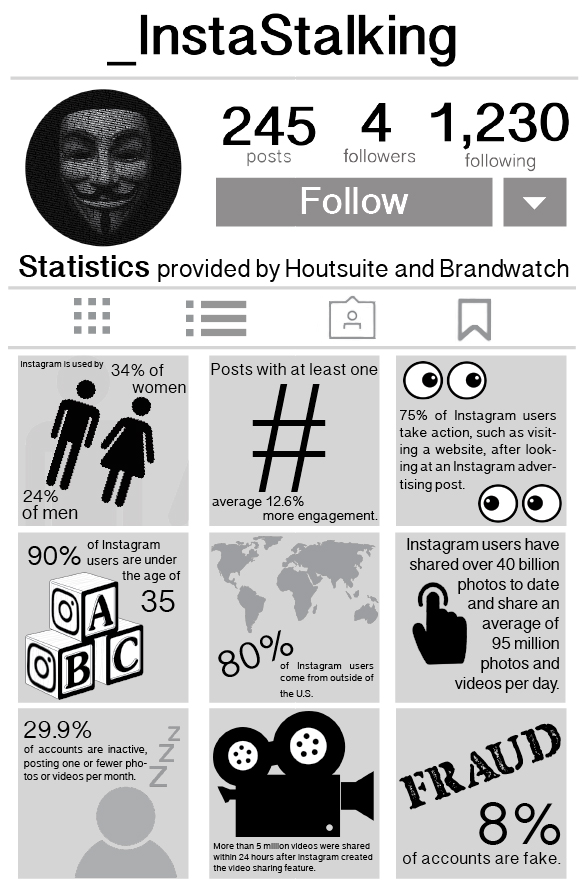Social Stalkers
May 16, 2017
Instagram–the land of overly-edited selfies, impeccably detailed pictures of lattes, and a plethora of aesthetically pleasing feeds–is also the kingdom which many online predators call home. The social media app contains over 600 million users (according to Statista) which are a mix of public and private accounts (though nothing is ever actually hidden).
The first pilfirer is Instagram itself. Like your parents have probably insinuated numerous times, even if you have a private account, your profile itself (with your name, witty bio, and portrait) is visible to the entire world, and the pictures you post, while intended solely for “followers,” are actually shared with third-party organizations who can target you with specific advertisements or sell your data to companies for research, according to the app’s website.
“We may share User Content and your information (including but not limited to, information from cookies, log files, device identifiers, location data, and usage data) with businesses that are legally part of the same group of companies that Instagram is part of, or that become part of that group (‘Affiliates’) . . . [and] with third-party organizations that help us provide the Service to you (‘Service Providers’),” explains Instagram’s privacy policy.
The guideline continues to specify about their purposeful commercial displays.
The second group to be aware of is that of the random, sometimes perverted or sexual, fake accounts. This classification of users is often the reason people feel the need to conceal their images from the public eye. Freshman Violet Wang comments on this issue.
“Well, I made it [my Instagram] private because I don’t want random people on the Internet to see my pictures because that’s kind of weird and they can just do bad things,” said Wang.
Sophomore Cassidy Cole (who also has a private feed) has a similar statement and shares her personal experience in dealing with those types of people: just don’t allow them to follow you or block them.
“Most of the people who follow me, I’ve either met or I’ve met through friends–I don’t let people who I don’t know follow me . . . There’s sometimes people that are really old that try to follow me, and I don’t understand how they found my account,” said Cole.
But what about people whose accounts are available for any person’s eyes? Many choose to open their lives for the sake of spreading their businesses (photography, jewelry, etc.) or gaining popularity for a specialization (athletes, dancers, artists, etc.). Senior Michael Faulknor weighs in on how he utilizes his public platform to promote his hobby and the types of digital prowlers he encounters.
“. . . I ride dirt bikes, so I try to get publically noticed sometimes. I do get a lot of fake females that are like, ‘If you want sex, click my bio[graphy] or something,’—more than I should. I get a lot of those and then just people from Spain or some foreign country with a non-English bio . . .” said Faulknor.
Because his account is accessible to society, Faulknor is also very cognizant of the nature of his posts in terms of their appropriateness.
“[I think about what I post more], like the captions and the hashtags. I just have to be careful. I don’t really do anything that dumb that I would post on social media,” said Faulknor.
Instead, he uses a separate (private) profile, now commonly categorized as the “finsta” (a combination of the words fake and instagram) to post more laid-back subject matter like inside jokes, silly pics, and in-depth tangents, which are more suitable for his small, selective followers (all of which are close friends) and not meant for communal consumption. Many teens have a finsta as the trend is rapidly spreading, which segues into the last body to be aware of.
You. Your friends. Your peers. Everybody has a little “stalker” in them. It includes anything from checking up on your favorite celebrity’s social medias five times a day, or clicking on a tag of a person in a photo which leads you into a twenty minute escapade of looking through their feed (whether it is a stranger or a friend of a friend of a friend). It’s not necessarily a bad thing, it’s just something to be aware of. Just because you have a “finsta,” or believe your account is hidden, it doesn’t stop your followers from screenshotting, sharing, or now anonymously “saving” posts (thanks to Instagram’s latest update). Cole talks about how careful you should be on any platform with the words and pictures you’re putting out.
“I use [my finsta] to post random things, or things that I think are funny. In some cases, somebody will post things about somebody else because they don’t think the person can see it, but people screenshot pictures and then it gets everywhere else,” said Cole.
The insightful message to be utilized here? Just be mindful of the actions you choose to share on the internet and who you allow to view them. Just because they’re digital followers does not mean they’re loyal or friendly.


